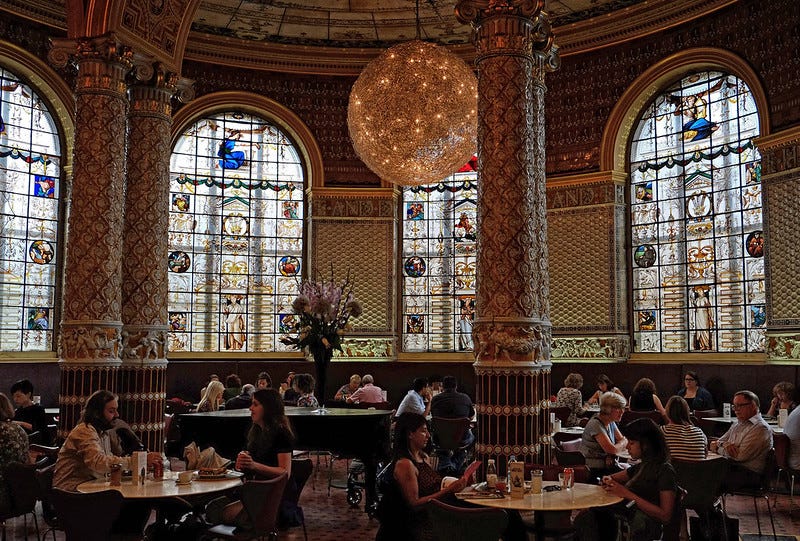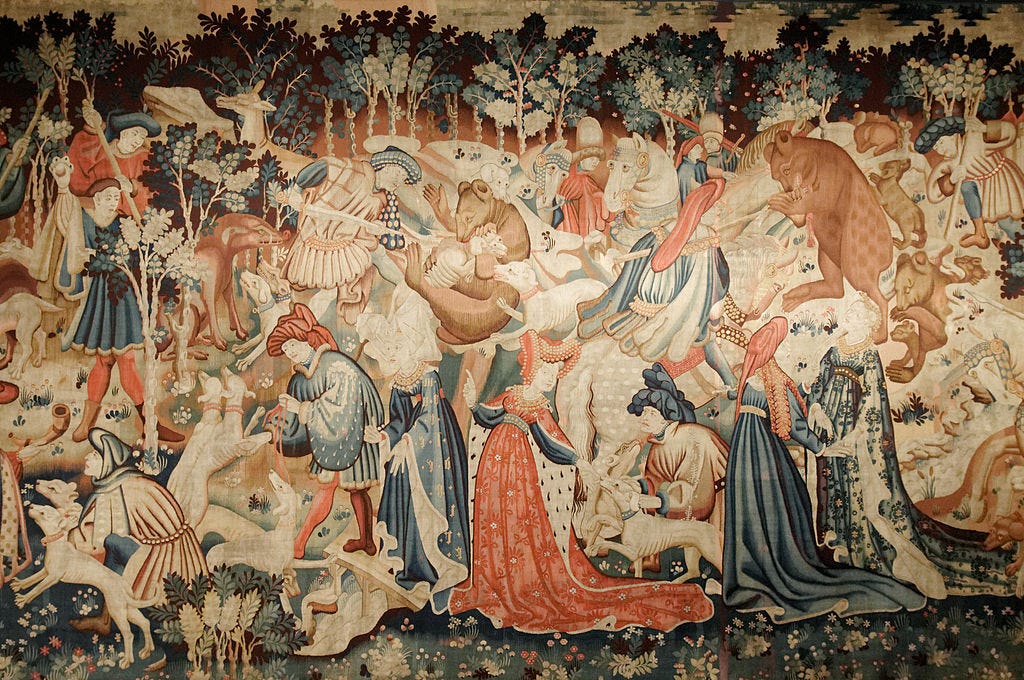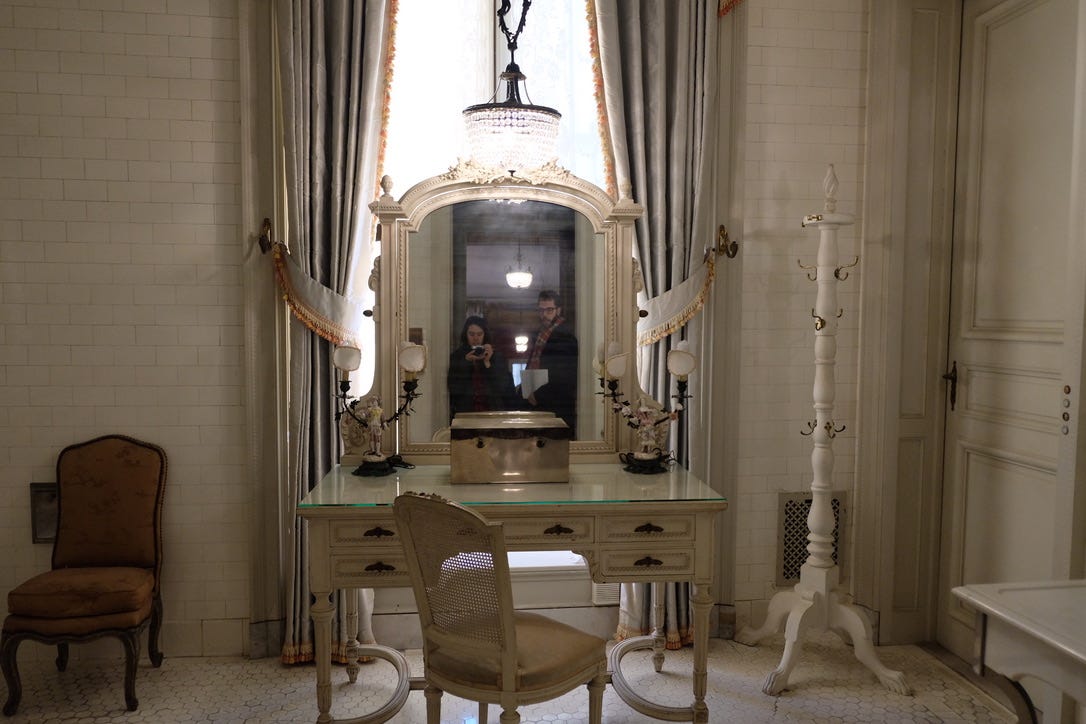
I've been reading a lot lately about the “errand hang.” If you're unfamiliar, it’s the practice of tagging along with a friend to do mundane tasks, rather than planning to catch up over an expensive dinner. You might grocery shop together, or run errands for a renovation project, or pick out a desk at IKEA.
I love a good errand hang. It’s comfortable, and it’s fun, and it makes boring tasks much more enjoyable.
But even more than the errand hang, I love the museum hang.
This weekend, I met up with a friend I hadn't seen in over a year. Instead of meeting over a meal, we ventured to the V&A in West London, which is a cavernous, maze-like museum. It contains art, jewelry, and clothing spanning centuries, if not millennia. We started in the museum cafe, but I don't think it would be right to say we were catching up. How do you catch someone up on the goings-on of an entire year? You can't, really, and something I have always appreciated about Lily is that it is impossible to talk small with her anyway. We met at a party two or three years ago, and the first time we hung out afterward, she asked me straightaway to list my most problematic views.
Perhaps it was the grand environment of the world’s first museum cafe that inspired us to plunge right into a deep conversation about the very fabric of humanity. Or maybe it’s just who we are. Either way, two hours passed while we questioned each other on how we built our values systems and whether objective morality exists.
I loved this. Immensely.
Later, we wove through the museum’s halls in search of the tapestries, which are 600 years old and which I could stare at for hours. These bits of thread weave as clear a picture as any of what life and humor and death looked like in the Middle Ages. We marveled over the craftsmanship and the vastness and the endurance of these tapestries, which have hung in great halls for centuries longer than our combined lives on Earth. We laughed at some of the depictions of lust. We wondered who the Medieval equivalent of Taylor Swift might have been, and then we agreed there is no adequate historic comparison.

There are endless rooms in the V&A, but the tapestry room is my favorite. It took months, if not years, for a team to weave these pictures by hand, many of them larger than my living room. We have so few of them left in the world today. In that same gallery a few months earlier, my friend Joshua and I sat and talked at length about the ways in which we make sense of relationships, and then enjoyed imagining the relationships and traditions of the people depicted in the tapestries. A few months before that, I saw the tapestry gallery for the first time when my writer friends Amelia and Steve came to visit (they both wrote about this as well). We questioned what it might have been like to work for Big Tapestry in 1432 and to have spent 10 years working on an apartment-sized masterpiece only to have the commissioner come back with "Just a few notes !" upon seeing the completed product.
Sure, it’s touristy, to go to a museum. But I’m a huge fan of playing tourist in the place where you live. I’d also argue that it lends a certain profundity to conversation, to chat whilst surrounded by so much stuff collected (or, um, stolen) from eras we can only imagine.
In a museum, I often feel both connected to history and protected from the passage of time and the demands of the moment. I like unexpected questions and long games of meandering “what ifs” and “would you rathers” and “what would you have done, if you were a peasant in 1312? Who would you have aspired to be?”

The museum hang piques curiosity and inspires this kind of silliness. It also grants the privilege of discovery and depth. It is incredible, how deep you can get while also taking breaks to ooh and ahh over how very old and well-preserved this medieval staircase is. There is always something to turn to if you need a change of subject or a thought-provoking question. Often, a simple interruption to say, “wow, look at that,” can spark a fascinating train of thought.
In London, we are spoiled for choice when it comes to museums and thought-provoking public spaces. There are nearly 200 museums, over 850 galleries, and 2,500 parks, gardens, and sculpture gardens within the city limits. The vast majority of these, including the V&A, are free to enter. But you don’t have to live in a big city to find a local history museum or landmark, or a historic house that does tours, or a pop-up exhibit at a public library.
Like most people, I haven’t often taken the time to visit tourist attractions close to where I’m living. “Playing tourist” at home is a new phenomenon for me. It really kicked off when I visited my parents in Rhode Island a few years ago and was carless for a few weeks. I was desperate to walk, and to go anywhere, and so I walked out the front door and did an “urban trek” for miles through Pawtucket, the city I grew up in, plus the two cities next door. I noticed historic markers I’d never seen before, and places where trees planted when I was a child had finally grown up and beautified a once-barren neighborhood.

It can be hard to play tourist on your own, as it can feel frivolous or foolish (though it shouldn’t!), which is why I love the museum hang. Over Christmas break, I spent a day touring museums in Newport, Rhode Island, with my high school friend Nick (aka Lima Bean). We both grew up in Rhode Island, but rarely spent time as kids exploring the literal wealth of museums that draw tourists from around the world. In the span of just a few hours, we toured two Gilded Age mansions—The Elms and The Breakers— the Sailing Museum, and the International Tennis Hall of Fame. In between anecdotes about family and relationships and our hopes for the future, we marveled at the opulence of the ballrooms before us. What was it like, we wondered, to be so wealthy that your “summer cottage” required a year-round staff of 43? To work as a servant and cater to the whims of someone who could drink your annual salary in a few glasses at dinner? To spend two whole months every year exclusively planning and attending parties and gossiping about the other old money families? Were they happy?
A few days later, I went back with my mother to take a guided tour of the servants' quarters at The Elms. The mansion was so opulent, so priceless, that it became nearly worthless in the 1960s—impossible to keep up as a private residence for summer holidays, so that no one in the family wanted it when its heiress died. It cost $1.5 million to build it in 1901, and was sold for $116,000 in 1962.
We learned that the wealthy owners and guests of these mansions had their servants change their bedsheets twice a day, and that high society women often changed outfits seven times before dinner. The servants would have to unpick every button before washing the clothing by hand, and then they'd have to sew them all back on. A single tablecloth could cost more than a servant's annual salary, and the good forks, knives, and spoons were kept in a walk-in silver safe, lest they walk away. I asked the guide so many questions about what life was like for staff, and on the ride home I did more research and asked Mom so many “what if?s”
Writing this now, I’m thinking of so many worthwhile museum hangs from the last few years. There was the New Bedford Whaling Museum with my family, where we got lost in imagining years of life at sea. At the Smithsonian National Postal Museum, my cousins and I wondered about a time when you could never be sure whether your letter exploded with the Hindenburg or you were just plain ghosted. Visits to art exhibitions with romantic interests have fanned some flames and extinguished others before we wasted our time. Sometimes the art is weird or the museum is boring or the historic interpretation feels flat. But even then, there’s people-watching and sarcasm and the roots of inside jokes.
One of my favorite stories I’ve ever published, for Gossamer Magazine, came out of a museum hang at the Hirshhorn in Washington, D.C. A few friends and I spent hours in line to see the Yayoi Kusama infinity mirrors when they rolled through town, and in return we were granted a few short minutes of eternity inside boxes of endless reflections. It was fleeting, this infinity, but I will remember it forever.

What I’m reading
An urgent reminder to wildly celebrate your single friends’ birthdays, a brilliant idea to rebrand the Kansas City Chiefs, the leaked track list for Tortured Poets Department (excellent sleuthing, Rob Shapiro), why we must surrender to uncertainty, how group chats rule the world, a gorgeous tour of well-kept journals, how right-wing conspiracy theorists imagine Taylor spends her days, Madeleine Dore’s soul-soothing “Things from the Days,” and Sherlock Holmes and the Case of the Possibly Flirtatious Texts (essential reading).
What I’m writing
A review of my ex-boyfriend’s titanium pot, how Taylor Swift is shifting international travel, why I love winter swimming, what I learned about Britishness on the England Coast Path, what happened when I let ChatGPT plan my hiking trip, and all my best pick-up lines for making new friends literally anywhere.
Thanks for reading! Is there something you’d like to see in a future issue of Out of Office? Write to me at kassondracloos@gmail.com or comment here. Make sure to tell me your favorite museum!




I had an editorial conference in the V&A Café last year. And yes, I got the book contract!